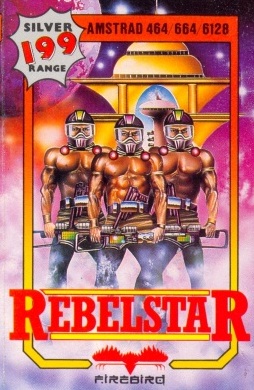
Alien 8 is an action-adventure video game developed and published by Ultimate Play the Game. It was released for the ZX Spectrum, BBC Micro, Amstrad CPC and MSX in 1985. The game is a spiritual successor to the best-selling Knight Lore, which was lauded by critics for its isometric graphics. In the game, the player takes control of a robot, Alien 8, whose job is to ensure that all of the cryogenically frozen passengers on board a starship remain viable during the ship's voyage.

Graeme Devine is a computer game designer and programmer who co-founded Trilobyte, created bestselling games The 7th Guest and The 11th Hour, and helped design id Software's Quake III Arena. He was Chairman of the International Game Developers Association (IGDA) from 2002 to 2003. One of Graeme's trademarks is his Scooby-Doo wardrobe. He has said of his work that "I've not stuck to any one genre, platform or IP throughout my career, and I hope people eventually work out that's just fine."

The Rebelstar games are a series of turn-based tactics video games designed by Julian Gollop. Rebelstar Raiders was published in 1984 by Red Shift for the ZX Spectrum. It was reworked in machine code as Rebelstar, published by Firebird in 1986. A sequel, Rebelstar II, was published in 1988 by Silverbird. Rebelstar, but not its sequel, was also adapted for the Amstrad CPC home computer.

Tau Ceti is a video game published in 1985 by CRL for the ZX Spectrum and converted to the Amstrad CPC, Amstrad PCW, Atari ST, Commodore 64, and MS-DOS. It was designed and programmed by Pete Cooke. The world, set on Tau Ceti III orbiting Tau Ceti, is displayed using 3D graphics with shadow effects. The planet has a day and night cycle.

Mission Omega is a computer game published in 1986 by Argus Press Software for the ZX Spectrum, Commodore 64 and Amstrad CPC home computers. It was programmed by Stephen Ward.

Winged Warlords is a ZX Spectrum game which was published by CDS Microsystems in 1983. It is a clone of Joust in terms of level design and gameplay. The graphics are different, with the ostrich mounts being replaced with winged horses.

Deactivators is a 1986 puzzle video game designed by David Bishop and Chris Palmer, developed by Tigress Marketing and System Software, and published by Ariolasoft's action game imprint Reaktor. The player controls bomb disposal robots known as deactivators and must use them to deactivate bombs planted by terrorists in five research complexes. The concept for the game came from a brainstorming session between Bishop and Palmer; its design and development took five to six months to complete. It was released for the Amstrad CPC 464, Commodore 64, and ZX Spectrum platforms in October 1986.
Andrew Glaister is a video game programmer.

Fairlight is an isometric projection arcade adventure video game developed by Bo Jangeborg and Jack Wilkes and released in 1985 on Softek's The Edge label. Developed in seven months, Jangeborg created the "Worldmaker" graphic development system to replicate the Filmation system used by Ultimate's Knight Lore. The game used code from a graphics utility he had developed in 1983, called Grax, which had also been the foundation of graphics package The Artist, published on Softek's SofTechnics label. Jack Wilkes contributed art assets towards the game, including enemy sprites and the title screen. A sequel, Fairlight II, was released in 1986.

Quazatron is an action game developed by Graftgold, and released in 1986 by Hewson Consultants. It was designed by Steve Turner for the ZX Spectrum.

Thief is an Apple II multidirectional shooter written by Bob Flanagan and published by Datamost in 1981. It is a clone of the 1980 arcade game Berzerk from Stern Electronics.

The Transformers is a platform shoot 'em up game based on the Transformers franchise. It was written by Denton Designs and released by Ocean Software for the Sinclair Spectrum and Commodore 64 home computers in 1986.

Megapede is a Centipede clone for the ZX Spectrum programmed by Andrew Beale and published by Softek in 1983. Beale also wrote a Berzerk clone, Robon, for the Spectrum.

Ostron, originally released as Joust, is a ZX Spectrum video game developed and released by Softek in 1983. It is a clone of the 1982 arcade video game, Joust.

Firebirds is a ZX Spectrum video game developed and released by Softek in 1983. It is a clone of the 1980 arcade game Phoenix.

Monsters in Hell is a ZX Spectrum game written by Martin Lewis and released by Softek in 1983. The player kills wizards by digging holes in the floor to watch them plummet to their death. The screen layout and gameplay are similar to the 1980 Universal arcade game Space Panic.
Edge Games, Inc. is an American video game developer and publisher headquartered in Pasadena, California, best known for the practices of its founder and chief executive officer, Tim Langdell, in enforcing trademarks relating to the word "edge", which sources have described as "litigious".

Superman: The Man of Steel is a 1989 video game featuring the DC Comics character Superman. It was developed and published by UK software company Tynesoft under license from First Star Software.

Zip Zap is an action game developed by Ian Weatherburn for Imagine Software and released for the ZX Spectrum in 1983.

Robot Attack is a clone of the arcade game Berzerk written by Bill Hogue and Jeff Konyu for the TRS-80 and published by Big Five Software in 1981. It was the first game from Big Five to include speech.



















